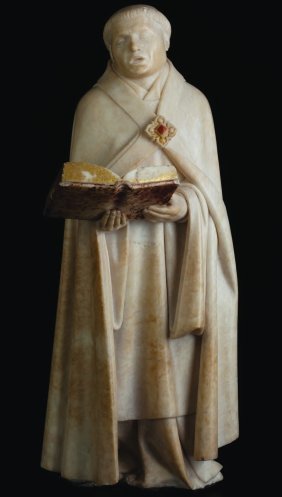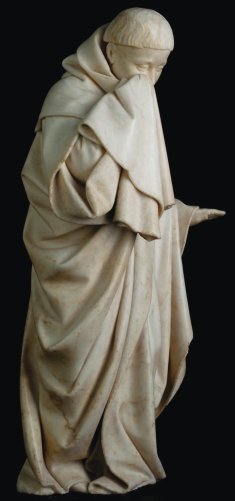Public expressions of grief, even at their most authentic, are a kind of performance. The tears may come spontaneously, but if we let others watch us cry it’s partly because we know tears communicate something beyond the reach of ordinary language: See what I cannot say—how much I miss him. The rituals of mourning translate raw grief into intelligible gestures that can be learned, mastered, and faked. At their best they are sincerely artificial, giving sorrow a fitting costume. At their worst (or at our worst) they become a trick for producing artificial sincerity. This theatrical aspect of mourning rituals has led to the suspicion that they’re essentially self-regarding. In the words of La Rochefoucauld, “Funeral pomp has more to do with the vanity of the living than the honor of the dead.”

A traveling exhibition of late medieval tomb sculptures, now at the St. Louis Art Museum, offers an eloquent answer to that maxim. It presents us with lots of pomp but very little vanity. Thirty-seven alabaster figures, most of them about sixteen inches tall, are lined up two abreast in a funeral procession. They are frozen in various attitudes of mourning. Some weep under their hoods, some sing; others read their prayer books or tell their beads (with rosaries that look like ropes of garlic cloves). All but a few are wearing heavy monastic cloaks, including some who aren’t monks: here and there we see courtiers with neat beards and ceremonial daggers. The uniformity of the clothing, which is part of the funeral pomp, tends to conceal the vanity of personality and rank; if this is theater, everyone is playing the same part, that of the official mourner.
Philip the Good had the statues made for the tomb of his father, John the Fearless, the second Valois duke of Burgundy. Sculpted between 1443 and 1457, they were set in an elaborate gothic arcade that circled the tomb under recumbent stone effigies of the duke and his wife. There the statues stood in single-file procession. Only one side of the them was ever meant to be seen, but visitors to this exhibition, who have the luxury of viewing them from several angles, might have trouble guessing which side, so carefully did the artists, Jean de la Huerta and Antoine Le Moiturier, carve every exquisite detail. As the mourning procession was a ritual performed in the sight of God, so the statues were designed to be seen by the One who sees everything.
Now all that was hidden for centuries has been revealed to us, if only temporarily. Once the exhibition has finished its tour of America (it opened at New York’s Metropolitan Museum of Art in March and, after leaving St. Louis, will travel to Dallas, Minneapolis, Los Angeles, San Francisco, and Richmond), it will make a final stop in Paris before the sculptures finally return to the duke’s tomb in Burgundy. The tomb was originally installed at the Carthusian monastery of Champmol, not far from the duchy’s capital, Dijon. Damaged during the French Revolution, the tomb and its decorations finally ended up in the main banquet hall of the ducal palace, which is now Dijon’s Musée des Beaux-Arts. The museum is currently undergoing renovations, so its director, Sophie Jugie, decided this might be a good time for the mourners to take their procession abroad.

They bring with them strange tidings of an age when powerful men cared as much about how their deaths and funerals would be remembered as about how their lives would be remembered. There was no doubt some vanity in this concern, but there was also evidence of Christian hope. For the dukes, death was not just the pitiable end of earthly glory, as it is for, say, Shelley’s Ozymandias (“Look on my works, ye Mighty, and despair!”). People like John the Fearless believed death was, or could be, the passage from one kind of glory to another. They knew it was likely to be a rough passage—they knew they weren’t saints—and so they surrounded themselves with as many holy companions as they could find, establishing religious communities whose members promised to attend their funerals and pray them quickly through purgatory. It helped if those who bore one from this life to the next were not themselves too weighed down with signs of earthly glory, which is why even members of the nobility put on heavy Carthusian robes for the procession. The mourner was, among other things, a walking memento mori, his clothes prefiguring death shrouds.
Why, then, after these conspicuous displays of simplicity, the elaborate (and very expensive) artistry of the tomb? Such monuments were for death a little like what modern wedding albums are for marriage: treasured memorials of initiation into a mystery that time threatens to bury. The tomb was designed not to impress museum-goers but to remind the Carthusians at Champmol to keep praying for the duke in case he hadn’t yet made it to heaven. Until he did, the procession continued.
One is immediately impressed with the naturalism of these fifteenth-century sculptures. Some of the faces have been slightly softened during the six centuries since they were carved, but they’re the faces one can still see in that part of France: the heavy-lidded eyes, long noses, and high cheekbones. Some of the faces are more expressive than others. Some seem to mask the emotions their hands or posture betray, and some are hidden entirely under cowls. Among the most palpably sorrowful figures are the ones we see the least of. The hand of one mourner, covered by his cloak, reaches up through the lowered cowl to wipe away tears, while the other hand lies flat against his chest. A few of the mourners seem to be reaching out to offer or receive comfort. One, Mourner No. 80, keeps his place in a book with one hand, pulls his cowl back with the other, and looks toward heaven, the arch of his brow suggesting he has seen whatever he was looking for.
It turns out there are at least thirty ways to wear a cloak. Even if you were a Martian, innocent of tears and dukes and tombs, you would know these statues were masterpieces by the way the sculptors managed to imply the shape and movement of individual bodies beneath those heavy uniforms of mourning. Some of the cloaks droop heavily, as if wet with tears. Others look as if they were about to lift their wearers off the ground. Each cloak somehow succeeds in revealing the person it covers, as the body is supposed to reveal the soul. And each shows us that these mourners are not just striking pious poses, but are actually moving forward, processing toward death and yearning for something beyond it. Yes, the ritual is carefully staged, and the gestures are mostly conventional (you may recognize some of them from funerals you’ve attended), but that yearning is real.

